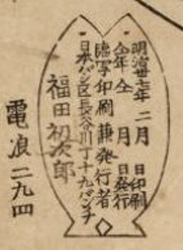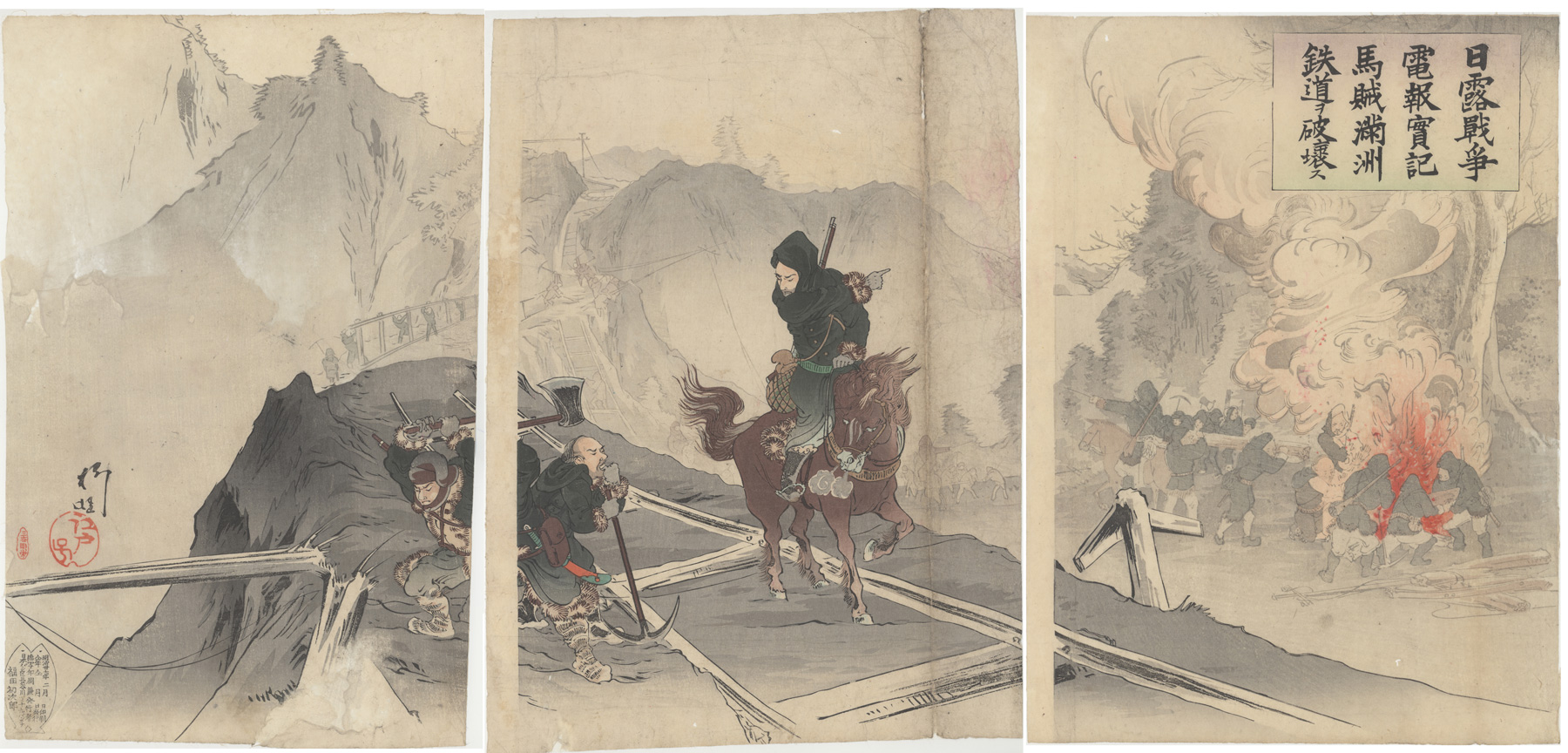About This Print
During the decade earlier Sino-Japanese War (1894-1895), the honghuzi often attacked the Japanese. (See IHL Cat. #81 Foreign-looking Manchurian Horsemen on an Expedition to Observe the Japanese Camp in the Distance Near Sauhoku.) During the Russo-Japanese War (1904-1905) "Japanese adventurers backed by the Imperial Army contacted such gangs and led themon harassing missions behind the Russian lines, blowing up bridges anddestroying railway lines in the name of the 'Righteous Army of Manchuria' (Manshū gigun).”1
The Chinese bandits, mention of whom has just been made, are the curse of Manchuria. These Chunchuses – the word is a corruption of the Chinese “Hung Hutzu” (Red Beards) – have preyed on Manchurian merchants for many years, deriving their living from gold-washing and occasional raids, together with a system known as brigand insurance. The suppression of these brigands has been one of the great policies of Russian administration; but, strange to say, great divergence of opinion exists as to its real value.
A celebrated writer, who knows the country well, says that in all the principal towns offices existed where the carters or bean boat skippers could purchase immunity, the outward and visible sign of which consisted of a small triangular flag, which insured the carrier, cart, or boat against molestation or pillage. Though theoretically reprehensible, in practice this system worked admirably, as the premium paid was not at all prohibitive. The Russians, by their expeditions against the brigands, who galled them rather severely, split up these united bands into several lesser sections, and without diminishing their numbers destroyed in a great measure their organization, with the result that the carters and bean boat skippers, unable to purchase immunity – the flag of one section being unrecognized by the others – could no longer ply their trade with the same degree of safety or, in fact, any safety at all. Accordingly both produce and lightstuff were prevented from coming forward in the usual quantities, the entire trade of the province being disturbed. It will be readily seen that this in its turn helped to swell the ranks of the disorganized robbers as, cut off from the legitimate exercise of their calling, the impoverished agriculturists and carriers had to become the preyers or the prey, the majority throwing in their lot with the former as yielding better return.
The same authority says: “It is dangerous to meddle with old-established customs in China, and many of the Chinese modes or procedure, theoretically incorrect though they be, are peculiarly adapted to the conditions prevailing. In the time of the China-Japan War these Hung Hutzu bands offered the Japanese the most obstinate resistance they met in the province. It will be a matter for surprise if in the present war they do not materially contribute to the many difficulties with which the Russian forces will find themselves confronted in operating in an intensely inimical country.”2
1 Bandits in Republican China, PhilBillingsley, Stanford University Press, 1988, p. 216.
2 Official History of the Russian-Japanese War: A Vivid Panorama of Land and Naval Battles, J. Martin Miller, 1905, p. 370-371.
Print Details
| IHL Catalog | #1224 |
| Title (Description) | Telegraphic Record of the Russo-Japanese War: Manchurian Mounted Bandits Destroy Railroad 日露戦争電報実記 馬賊満州鉄道ヲ破壊ス Nichiro sensō denpō jikki: Bazoku Manshū tetsudō o hakai su |
| Artist | Utagawa Kokunimasa 小国政 (1874 – 1944) |
| Signature |  |
| Seal | 江戸子 Edoko ("true Tokyoite") (see image above) |
| Pub. Date | February 1904 (Meiji 37) |
| Publisher |  The characters 電浪 二九四 appearing to the left of the seal are likely the publisher's phone number, although "telephone" is normally seen as 電話 ("denwa") instead of 電浪 ("denrō") as written here which can be translated as "electromagnetic waves". |
| Engraver |  |
| Impression | excellent |
| Colors | good |
| Condition | poor - extensive paper thinning and missing paper; irregular trimming left panel; vertical fold and separation; staining; paper loss bottom margin; center panel; paper thinning, worm hole right panel |
| Genre | nishiki-e, senso-e (Russo-Japanese War) |
| Miscellaneous | |
| Format | vertical oban triptych |
| H x W Paper | R: 13 5/8 x 9 7/8 in. (34.6 x 25.1 cm) C: 13 3/4 x 10 to 9 3/8 (width variable) in. (34.9 x 25.4 to 23.8 cm) L: 13 5/8 x 9 to 8 1/2 (width variable) in. (34.6 x 22.9 to 21.6 cm) |
| H x W Image | R: 13 5/8 x 9 3/8 in. (34.6 x 23.8 cm) C: 13 3/4 x 9 3/8 in. (34.9 x 23.8 cm) L: 13 5/8 x 9 to 8 1/2 (width variable) in. (34.6 x 22.9 to 21.6 cm) |
| Literature | Conflicts of Interest: Art and War in Modern Japan, Philip K. Hu, et. al., Saint Louis Museum of Art, 2016, p. 217, pl. 94 |
| Collections This Print | Glasgow University Library Special Collections Department Prints of the Russo-Japanese War Sp Coll e159; Future University Hakodate - Digital Archives Center 1114234865-1114234865(1) (2) (3); Noda Public Library c17; Digital Collections of Keio University Libraries; Shizuoka Prefectural Central Library K915-108-050-014; Saint Louis Museum of Art 609.2010a-c |
4/15/2020
3/30/2020


